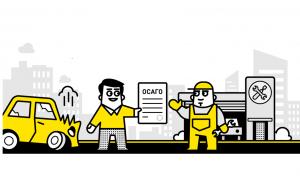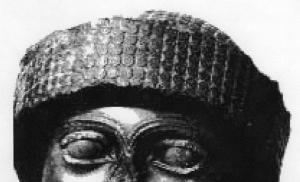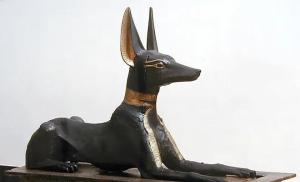Incredibly difficult puzzles (9 photos).
As you know, small but tricky tasks, often called “puzzles,” help to “stir up” the brain. Usually these problems are more logical in nature than mathematical. What is the difference?
The fact is that when solving a mathematical problem, you usually need to use one or more theorems, remember axioms or formulas. There are also mathematical ones, but let's focus specifically on puzzles that require ingenuity, breadth of thinking and the ability to abstract in order to find the correct answer.
There are different types of puzzles, but is there one that makes more than one million people work to solve it? Of course, the most difficult puzzle in the world exists! Get ready to rack your brains for more than one evening.
The most difficult puzzle in the world: the battle of people and gods
This is the name of the puzzle proposed by the American logician and philosopher George Boulos. It was first published in the Italian newspaper Republic in 1992.

It is noteworthy that Boulos did not even allow inquisitive minds to suffer and attached a solution to the puzzle to the same article. So, the content of the logic puzzle is as follows. There are three gods that are familiar to each other (Boulos suggests using A, B, and C in no particular order): the god of lies, the god of truth, and the god of chance. The god of truth speaks only the truth, the god of lies only lies, the god of chance can speak both the truth and lies in any order. We need to determine who is who by asking just three questions, the answer to which can only be “yes” or “no.” Each question can only be asked (you cannot ask everyone at once). The gods understand human language, but they prefer to answer in their own way. In their language there are two words - “ja” and “da”, and we do not know which word is “no” and which is “yes”.
The most difficult puzzle in the world: some explanations
Boulos also slightly expanded the problem statement, adding the following points:

- One god can be asked more than one question. Thus, it may turn out that someone will not get one.
- The next question can be formulated only after receiving the answer to the previous one.
- The god of chance chooses the answer to a question by tossing a coin that is in his head.
- It is forbidden to ask “paradox” questions, for example, “Are you going to answer “ja” now?
The most difficult puzzle in the world: tips for the solution
The philosopher and logician Boulos proposed to begin by calculating either the god of lies or the god of truth. To do this, you can use complex logical connections in the question. For example, the following questions might be asked:
- Does it mean that “da” is “yes”, despite the fact that you are the god of truth, and B is the god of chance?
- Is there an odd number of true statements in this list: “da” means “yes”, you are the god of lies, B is the god of chance?
Thus, the most difficult puzzle requires you to first determine which answer means "yes" and which means "no." Next, based on this, we need to move on to the definition of gods. By the way, you could identify one of the gods already in the first question (if you used one of the approximate options proposed above). We will not reveal all the secrets of the solution, because the most difficult puzzle game can be within your power if you think logically. Remember that you only have two questions left. Formulate difficult questions. You will determine the last god by elimination.
In this article we will look at the most interesting puzzles intended for children, but not every adult can master them. They managed to stupefy more than one Internet user and gained enormous popularity on the Internet, as did comic tests with answers - but how quickly can you cope with them? The correct answers are waiting for you at the end of the article!
Where does the bus go?
If we talk about the most popular children's tasks on the Internet, this is one of them. Here is a picture of a bus. Which way is he heading?
How many points are there?
More attentiveness tasks for the most eagle-eyed users: how many black dots do you see at the intersections of lines?

Which circle is bigger?
Now let's solve interesting graphic puzzles. Can you answer which of the yellow circles shown in the picture is larger?

Moving the matches
The following children's puzzles are also often given to first-graders to solve: they require you to move matches in a certain way to get a given figure.
Find the panda!
The Internet was also blown up by the following graphic puzzles by artists who placed an image of a panda in complex pictures and invited other users to find it. They hid the panda in the crowd of stormtroopers from " Star Wars”, in a gathering of metalheads, and even tried to hide her among the myriad of massage tables. Check your attentiveness!



Japanese IQ test
But what kind of IQ test did the Japanese come up with? On the shore there is a man with two sons, a mother with two daughters and a policeman with a criminal. In front of them is a raft on which they need to get to the other side. Try to think about how they can be transported there, taking into account such interesting conditions:
- Only two people can fit on the raft at a time, and it cannot float without people at all.
- Children can only travel on the raft with an adult. But sons cannot remain alone with the girls’ mother, and daughters cannot remain alone with the boys’ father.
- And the criminal cannot be left alone with others without the supervision of a police officer.

Found the answer? If not, watch this interesting test in the video:
Right answers
There can be two correct answers to this puzzle. The first is that the bus goes to the left, since on the other side, invisible to the viewer, there are doors through which passengers get inside. This answer is valid for our roads with right-hand traffic. But for countries where traffic left-handed, the correct answer is right.

The picture shows parking spaces, and a car occupies one of them. If you turn the picture over, you will realize that you originally saw the numbers upside down. Therefore, the number under the car is 87. No matter how much you try to calculate some clever polynomial here, such interesting puzzles are not designed for algebraic logic, but rather for ingenuity.

Missing value = 2. To solve such children's puzzles, you need to put yourself in the shoes of the children. Do kids know how to decide? complex equations, count arithmetic progressions? But they notice that the values in the columns depend on the number of circles in each set of numbers. Let's take, for example, the row 6855: in the number 6 there is one circle, and in the number 8 there are two, so the output is 1+2 =3, that is, 6855=3. And in row 2581 only the number 8 has two circles, so the solution is 2.

There are 12 points in total in the figure. But our brain is designed in such a way that it does not allow us to see them all at the same time, so at a time we can only notice three or four black dots.

The mugs are exactly the same! Such simple puzzles are built on visual illusion. The blue circles on the left side of the picture are large and some distance from the yellow one. The circles on the right side are small and stand close to the yellow circle, which is why it seems to us that it is larger than the first one.

Here's how to solve interesting children's puzzles with matches:

Unmasking the panda:



Intelligence is the most important thing that distinguishes people from other representatives of the animal world. Man used his mind to achieve unprecedented heights in science and technology, but sometimes the games of the mind were not only of a purely practical and utilitarian nature: this is how many different puzzles were born, to solve which you have to thoroughly “use your brain.” You will find ten of them in this collection.
1. The most difficult Sudoku in the world
One of the most popular types of crossword puzzles in the world is Sudoku - Japanese puzzle with numbers. Its principle is simple, so many amateurs try to create their own versions. In 2012, Finnish mathematician Arto Incala claimed to have developed “the world’s hardest Sudoku.”
As the British newspaper “The Telegraph” reports, if the simplest of the common variants of Sudoku on the difficulty scale are designated as “1”, and the most complex of the popular ones are rated as “5”, then the version proposed by the mathematician is “11”.
There are three gods, A, B, and C, one of which is the god of truth, another the god of lies, and the third the god of chance, and it is not clear which is which. The god of truth always tells the truth, the god of lies deceives, and the god of chance can say both in any order. It is necessary to determine who each of the gods is by asking three yes or no questions, each question being asked of only one god. The gods understand the questions, but answer in their own language, which contains the words “da” and “ja”, but it is not known which word means “yes” and which “no”.
This logical problem, authored by the American philosopher and logician George Boulos, was first published in the Italian newspaper “la Repubblica” in 1992. In the comments to the riddle, Boulos makes important note: Each god can be asked more than one question, but more than three cannot be asked.
3. The most difficult sum-do-ku in the world
One of the popular varieties of Sudoku is sum-do-ku, also called “killer Sudoku”. The whole difference is that the sum-do-ku is given additional numbers- sums of values in groups of cells, while the numbers contained in the group should not be repeated. In the popular puzzle service Calcudoku.org, you can track the difficulty rating of published problems, one of them was sum-do-ku, which is depicted here.
4. Bongard's most difficult "Problem of Recognition"
This type of puzzle was invented by the outstanding Russian cyberneticist, the founder of the theory of pattern recognition, Mikhail Moiseevich Bongard: in 1967, he first published one of them in his book “The Problem of Recognition.” The “Bongard problem” gained wide popularity when the famous American physicist and computer scientist Douglas Hofstadter mentioned them in his work “Gödel, Escher, Bach: This Infinite Garland.”
The two most complex examples such problems are taken from Foundalis.com, to solve them you must find a rule that matches the six images on the left page, but does not match the six pictures on the right side.
5. The most difficult tracing paper puzzle
This type of Sudoku is similar to sum-do-ku, but, firstly, any arithmetic operations are used to calculate the value of the cells, not just addition, secondly, the field can be a square of any size (the number of cells is not limited), and -third, unlike Sudoku, there does not have to be clues from 1 to 9 in each 3x3 square. Such problems were developed by Japanese mathematics teacher Tetsuya Miyamoto.
Here you can try to figure out the most difficult calcu-doku, which was published on Calcudoku.org on April 2, 2013. Only 9.6% of regular visitors to the resource managed to solve it.
It is necessary to develop an information storage system that would encode 24 bits of information on eight disks of four bits each, provided that:
Eight 4-bit disks are united by one 32-bit system, in which any function from 24 to 32 bits can be calculated with no more than five mathematical operations from the set (+, -, *, /, %, &, |, ~).
After the failure of any two disks out of eight, these 24 bits of information can be restored.
On the IBM website there is a regular column “Think About This!”, in which curious logic problems. The task given here is one of the most difficult.
7. Kakuro's hardest puzzle
Kakuro puzzles combine elements of Sudoku, logic, crosswords and basic math. The goal is to fill the cells with numbers from one to nine, and the sum of the numbers in each horizontal and vertical block must agree with specified number, and numbers within one block should not be repeated. For horizontal blocks, the required amount is written directly to the left, and for vertical blocks, at the top.
This example of one of the hardest kakuro puzzles is taken from the popular puzzle resource Conceptispuzzles.com.
8. One of Martin Gardner's problems
American mathematician Martin Gardner is the author of many different problems and puzzles. One of his most interesting works is calculating the number that will require the fewest steps to reduce it to a single digit by multiplying the digits of that number. For example, the number 77 will require four such steps: 77 - 49 - 36 - 18 - 8. Gardner calls the number of steps the “persistence number.”
The smallest number with a toughness number of one is 10, for a toughness number of 2 it would be 25, the smallest number with a toughness number of 3 is 39, if the toughness number is 4 the smallest number for it would be 77. What is the smallest number with a toughness number of 5 ?
9. The most interesting problem from the game Go
Go was invented in China more than 2.5 thousand years ago, making it one of the most ancient games on Earth. Despite enough simple rules, it continues to attract thousands of people with the opportunity to solve interesting strategic problems. The goal of the game is to fence off a larger area than the enemy with stones of your own color. The situation depicted above is one of the most difficult in the history of Go: the most experienced players spent more than 1 thousand hours of game time solving it. How can black win in this game?
10. The Hardest of the Fill-A-Pix Puzzles
Fill-A-Pix was invented by English mathematician Trevor Truran. This game is similar to the well-known “Mineweeper”: the player must, guided solely by logic, determine which cells should be colored and which will remain empty until the image is formed. Since several key values affect one cell at once, it will take some time to obtain the final image.
: https://p-i-f.livejournal.com/
Will help you develop memory and intelligence different types puzzles for adults - logic tasks, complex, funny or tricky questions, a variety of intellectual math games.
Logic games and puzzles for adults
Solving various logic puzzles does not require a high level of education; starting to solve them is a useful activity for absolutely everyone. A variety of trick riddles for adults train non-standard thinking, which will help in learning. Everyday life find faster rational decisions in difficult everyday situations.
Riddles for adults
This type of task will allow you to immediately check the correctness of the solution you have found. What's good about these short riddles? Based on the answers, you can make a thematic selection for a specific holiday or feast to entertain guests. Depending on the lineup of guests, tricky riddles, tasks that will make your friends laugh, or math problems are good options.
With a catch
In tasks with a trick, the question itself often looks illogical at first glance, for example: what language is spoken silently? When the answer is announced, the person’s first reaction manifests itself as disagreement with it. At first glance, the question and the chosen answer are connected in an unusual way and with double implications. But after thinking a little, you can’t help but agree that such a daring decision is correct and very logical (answer: in sign language).
funny

Play guessing game funny riddles- pure pleasure. While your guests are expressing possible answers to tricky questions, the whole company is guaranteed to be shaken by bursts of laughter.
Mathematical

In such riddles, you need to guess a given number, or calculate the result, relying less on arithmetic than on intelligence. The answer that seems obvious and seems to lie on the surface is often incorrect.
Mind games

Logic problems for adults are multi-step combinations for training thinking. To solve them correctly, you need to think through your actions several steps ahead. Such tasks are relatively difficult; they often come in the form of original pictures, where you need to rearrange or complete some elements.
Solving puzzles makes people happy: it's very satisfying to know that you just figured out the answer to one of the most difficult logic problems in the world. However, this is not the only reason why you need to solve puzzles at least sometimes. Read about other reasons, the most complex logical problems, and the benefits of solving them in the article.
The most difficult logic puzzle
The most difficult task is named just that. People call it the “Battle of Men and Gods.” The most difficult logical problem was first proposed by a philosopher and logician from the United States of America. His name is George Boulos. The whole world learned about this puzzle after its publication in the Republic newspaper, which is published in Italy. This happened in 1992.
Condition
The most difficult one looks intimidating from the very beginning. How is its condition written? Let's say there are three gods who know each other. One of them is the god of lies, the other of truth, and the third of chance. It is customary to designate them with the letters A, B and C, using the letters in random order.
The god of lies always speaks only lies, the god of truth, on the contrary, says only And finally, the god of chance can speak both the truth and lies, but it is impossible to predict what he will say now.
The challenge is to figure out who each god is. To do this, you can ask only three questions. The most difficult logical problem implies that all these questions can be addressed either to one god or to each, but in turn. It all depends on the answers received. Questions should only require an affirmative (“Yes”) or a negative (“No”) answer.
It is indicated that the gods understand the language in which questions will be asked, but they answer in their own. You may hear either the word Ja or Da. It is unknown which one means “No” and which one means “Yes”.
- Questions can be asked in different ways: ask something from each of the gods, or not from all of them.
- Only after The answer is received, you can ask the next question.
- The God of Chance decides what answer to give using a coin in his head.
- There is such a thing as a “paradox question”. An example would be the expression: "Are you going to answer 'Ja'?" So, such questions cannot be asked.
Solution
Boulos, the logician and philosopher who created the problem, suggested the solution in his article. The first thing to do is to figure out the god of truth or the god of lies. To do this, you should create a question with complex logical connections. It should sound something like this: “Suppose you are the god of truth, B is the god of chance, will Da mean “yes”?” Of course, this is not an exact wording, it is only an approximate version. Using this question you can identify one of the gods. Then it all depends on how to ask two more questions.
Sudoku "Escargot"
Many people are familiar with games that focus on rearranging numbers in Sudoku. The solution to this puzzle is great way do a 5-minute brain workout. Perhaps you are good at solving Japanese Sudoku. But can you solve the most difficult problem in your group?

AI Sudoku is an algorithm for creating complex Sudoku, built by a mathematician named Arto Incala in 2012. IN Lately More and more bots are appearing, but this one is considered the most difficult. It's called Escargot. Along with the main task, you can find 19 other difficult Sudokus, which were also created by the bot.
To find a solution to the most difficult logical Sudoku problem in the world, you need to allocate a sufficient amount of time for this. The British publication The Telegraph reported that on the difficulty scale of Sudoku “Escargot” is rated at 11 points, while the usual puzzles of increased complexity “pull” 5.
Recognition problem
Mikhail Moiseevich Bongard, a Russian cyberneticist, first published an example of a logic puzzle in his book in 1967 called "The Recognition Problem". However, Bongard's very complex logic problems gained popularity later. This happened after the American scientist Douglas Hofstadter wrote about them in his book.

To find a solution to the Recognition Problem, it is necessary to identify a certain pattern, or rule. The six images on the left page follow this rule. Accordingly, the images on the right page do not fit it.
Durability number
Martin Gardner is an American mathematician who is the author of large quantity various puzzles and tasks. The most famous of them is the search for the “persistence number”. The idea is to reduce a certain number to one digit in the least number of steps. To do this, you need to sequentially multiply the component numbers.
The most common example of a solution is “77”. You can reduce it to one number in a few steps. 7*7=49, 4*9=36, 3*6=18, 1*8=8. The action was performed four times, this is the “number of endurance”.
On specialized information resources Many different kinds of puzzles are published on relevant topics, including the most complex logical problems - with answers, hints, solution algorithms, etc. They always arouse keen interest, so if you want to keep yourself or your friends busy on a dank, damp evening, take advantage of this opportunity or even try to come up with a task yourself. Believe me, finding “persistence numbers” is a very exciting activity.
Riddle for geniuses
According to statistics, real geniuses find a solution within ten seconds. According to surveys, logical problems - complex, with a trick - do not cause any particular difficulties for Harvard graduates; they take no more than 40 seconds to complete this task. For example, Bill Gates passes this genius test in 20 seconds. 15 percent of the world's inhabitants are gifted people; they find a solution in two minutes. Now look at this picture and guess which figure is the odd one out.

The answer is: figure number one. She doesn't have common features with the rest of the images. Judge for yourself, figure No. 2 does not have a white frame, and No. 3 is the only circle. While all the other pieces are red, No. 4 is green, and No. 5 is obviously smaller than the others. Thus, only the figure number one has no striking differences from most of the images, which is its main... difference.
Islanders
Other interesting riddle is also associated with lies and truth. Let's say two tribes live on an island. Liars always lie, but good people, on the contrary, always tell the truth. A traveler who met an islander asked him a question to find out who he was. He said that he was a great guy, and he was hired as a guide.
During the journey, the travelers saw another islander, who, judging by according to the attendant, also claimed that he was great. Attention, question! How to determine whether the conductor was a liar or a good fellow?

The answer is: on this island everyone says they are great. Since the guide correctly conveyed the islander’s answer to the traveler, it is clear that he is a good fellow.
Football teams
Above, both medium and very complex logic problems were presented to your attention. With the answers written at the end, it is, of course, easier to solve them. And to strain your brain even more, you can create additional difficulties for yourself: do not write down the condition and try to find the right decision in the mind. So here's another puzzle.

There are several football teams. On standings“Torpedo” takes first place, “Spartak” is fifth. Dynamo is in the middle between these two teams. Next, you need to be very careful: if Spartak is ahead of Lokomotiv, and Zenit takes place right after Dynamo, which of the five teams will take second place? You must answer within 30 seconds. It will sound like this: “Locomotive”.
Internet puzzles
The Internet can be called a repository of puzzles. But many tasks require basic technical skills, such as finding source pages for tips or modify image files. Remember that complex logic problems are designed to test your intelligence, not test your computer skills.
NSA Periodic Puzzle
Agency national security does not have the best reputation, as it has been repeatedly suspected of spying on Internet users and violating confidentiality. If you do not take this into account, you can find quite complex logic problems with answers on the official website of periodic puzzles. New tasks appear monthly. The answer is published a few days after the question. The NSA Puzzle periodical was launched just last year, which means that a collection of more than 12 puzzles is already available.
Blue Eyes
It's very interesting to work on a solution difficult riddle over several days or even weeks. For patient people, the most difficult logic puzzle in the world called Blue Eyes will suit you. According to XKCD - the best web platform for child prodigies, it develops logical, mathematical and lateral thinking.
The creator of the puzzle heard it completely by accident and published it on the Internet. At the same time, he did not even use words. To find the key to solving it, you need to read the riddle, retell it and try to mentally find the answer to it. The most difficult logic problem in the world is very exciting, it takes up all your free time.
"101 Friday Puzzles" or Richard Wiseman's 101 Puzzles
A professional psychologist named Richard Wiseman became an Internet celebrity thanks to his YouTube channel. He publishes various illusions, tricks, etc. on it. On Fridays, a man shares another puzzle or riddle on his blog. Solving them requires a combination of linear, lateral and creative thinking. Famous and also other riddles and problems based on images can be found on the psychologist's blog.
"Logic labyrinths", or Robert Abbott's puzzles
Robert Abbott is a programmer, logician and game developer. Fame came to him after the publication of “Logical Labyrinths”, which are in free access. The essence of this puzzle is to go through a maze with given rules.

The very first game, by the way, the simplest one, called Easy Maze 1, must be overcome without turning left.
What are puzzles and logic problems for?
Puzzles and various logical tasks have several positive qualities. Firstly, they train the human brain, secondly, solving them is very interesting, and thirdly, they allow you to develop certain character traits.
How useful can puzzles be for children?
- They develop perseverance in restless children.
- They train problem solving skills.
- Perseverance is another quality that puzzles develop in children. After all, as you know, puzzles are difficult to solve the first time, for this you need to be patient.
- Improves hand coordination and fine motor skills, When we're talking about about puzzles like the Rubik's cube.

Of course, all the most important character qualities are laid in children at an early age, and logical tasks greatly contribute to this. However, they are also useful for adults who have long graduated from school. The brain needs to be trained just like the body.
- In order for brain cells to age more slowly and less, it is necessary to regularly arrange procedures for them to “rejuvenate”, namely, allocate time for solving puzzles.
- Logical tasks stimulate thought processes. Answers to life's most difficult questions will come much faster if you regularly train your brain.
- There is an increase in serotonin levels. At the same time, the mood improves, but most importantly - blood vessels, which nourish the brain, begin to renew themselves.
- Memory improves. With age, problems arise with remembering dates, names, and things to do. Crosswords, puzzles and logic problems are best for developing memory.













